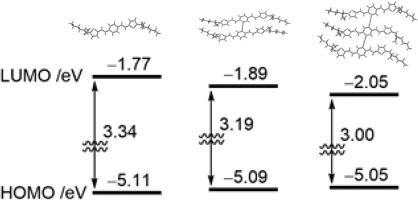Journal of Photochemistry and Photobiology A: Chemistry ( IF 4.3 ) Pub Date : 2020-07-11 , DOI: 10.1016/j.jphotochem.2020.112756 Kenji Mishima , Taishi Sakai , Kazumichi Yokota , Masateru Taniguchi , Yoshio Aso , Yutaka Ie , Koichi Yamashita

|
Along with the recent intensive studies on improvements in organic solar cell efficiency, a new material design concept of organic semiconductors has become important for the practical realization of solar cells. Donor materials with a high dielectric constant that markedly boost the efficiency have been proposed, but theoretical material designs and/or experimental results are still scarce. In this paper, we report on a combined theoretical and experimental result of donors with high dielectric constants. Our design guidelines were to bind a conventional one-dimensional thiophene-based donor molecule in a two-dimensional (2D) manner, which would lead to extended π-conjugation and a large dielectric constant. Impedance spectroscopy measurements showed that the relative dielectric constant increased unilaterally with extending the 2D structure. Organic solar cells based on these materials in the combination of [6,6]-phenyl-C61-butyric acid methyl ester (PC61BM) show that an increase in power-conversion efficiency was observed experimentally with increasing the extension of the molecular structure. These sults imply that this is a potentially promising design strategy for the 2D extension of the molecules, and it eventually leads to a high dielectric constant and to an efficient power conversion of the organic solar cell material.
中文翻译:

二维结构对介电常数和光伏特性的影响
随着最近对改善有机太阳能电池效率的深入研究,有机半导体的新材料设计概念对于太阳能电池的实际实现已变得重要。已经提出了具有高介电常数的供体材料,其显着提高了效率,但是理论材料设计和/或实验结果仍然很少。在本文中,我们报道了具有高介电常数的供体的理论和实验结果相结合。我们的设计指南是以二维(2D)方式结合传统的基于一维噻吩的供体分子,这将导致π扩展。-共轭和大介电常数。阻抗谱测量表明,相对介电常数随二维结构的扩展而单侧增加。基于这些材料的有机太阳能电池与[6,6]-苯基-C 61-丁酸甲酯(PC 61 BM)结合使用时,实验观察到随着分子延伸的增加,功率转换效率提高了结构体。这些结果表明,这是分子2D延伸的潜在有前途的设计策略,并且最终导致有机太阳能电池材料的高介电常数和有效功率转换。


























 京公网安备 11010802027423号
京公网安备 11010802027423号